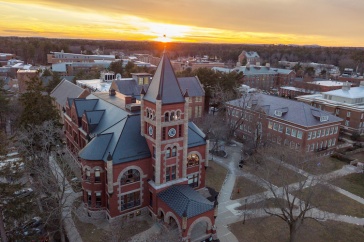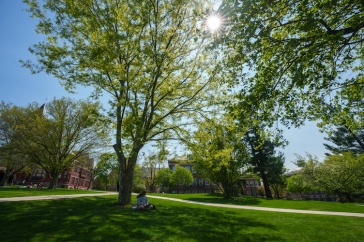Two faculty members from the College of Engineering and Physical Sciences (CEPS) have received recognition from the Geological Society of America.

Professors Jean Benoit, civil and environmental engineering, and Joel Johnson, Earth sciences, were part of two research teams recognized with the Edward Burwell Jr. Award and Kirk Bryan Award for Research Excellence, respectively.
“Joel and Jean are scholars of the highest quality, and I am pleased to hear that they have been acknowledged for their contributions,” says Charles Zercher, CEPS interim dean. “They are terrific examples of how UNH faculty members are impacting the world through their scholarship.”
Better Understanding a Tragedy
Benoit’s research sought to better understand landslide safety following a deadly March 2012 landslide in Oso, Washington, during three weeks of intense precipitation. The landslide was a sudden event that destroyed homes and a section of highway and claimed 43 lives.
Benoit and his colleagues documented the aftermath through field observations and historical data with a team from the Geotechnical Extreme Events Reconnaissance Association (GEER). The GEER team collected an array of data to determine the factors that contributed to the landslide and provided broader lessons for those involved in assessing landslide safety.
Benoit said it was heart-wrenching to work at a site where people lost their lives, but the research represents the highlight of his career as a geotechnical engineer.
“This was an unbelievable opportunity to work with a team of experts and make a contribution to the area of landslides,” said Benoit. “I was happy to help in a small way to better understand landslide failure mechanisms in order to hopefully minimize future losses of lives and property.”
Established in 1968, the Edward Burwell Jr. Award honors the published paper of distinction that advances knowledge concerning principles or practice of engineering geology or of related fields of applied soil or rock mechanics where the role of geology is emphasized.
Seismic Activity in the Northwest
Johnson’s research findings were recognized for their important contribution toward the study of large subduction-zone earthquakes in the Pacific Northwest. Johnson and his colleagues reconstructed the history of earthquakes of magnitudes between eight and nine that have occurred during the past 10,000 years along the Cascadia margin, which runs from Vancouver Island to northern California. They did so through the dating and correlation of submarine slope failures triggered by these events. The findings provided an indication of how frequently previous events occurred and help predict future events.
Johnson noted that the work is significant because it represents one of the longest — if not the longest — paleo-seismic records on any subduction zone.
“Recognition of our work is a real honor for all of us,” Johnson notes. “It was a team effort and a massive undertaking that resulted in a data set that greatly improves our understanding of seismic hazards in the Pacific Northwest.”
Johnson began his research on the subject in 1999 and 2002 during cruises to the region to collect sample cores. He dedicated much of his doctorate research on the original data set for a 2003 publication and additional dating and correlation work for a 2012 publication.
The Kirk Bryan Award is given for a publication of distinction advancing the science of geomorphology or quaternary geology. It is considered the oldest and most prestigious of the GSA Quaternary Geology and Geomorphology Division’s awards.
-
Written By:
Brooks Payette | College of Engineering and Physical Sciences



















































